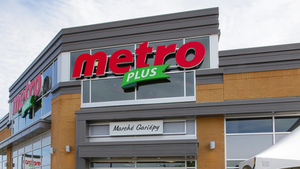SUPERCENTER FORMAT SEEN BOLSTERING TARGET'S GROWTH
WHITE SULPHUR SPRINGS, W.Va. -- Target Corp., Minneapolis, has the potential to be fully four times its current size in a decade's time as it focuses on applying its upmarket strategy to the supercenter food format, Jerry Storch, Target's vice chairman, said last week.Application of Target's differentiation tactic to its supercenters has the potential to yield a company that's $45 billion larger in
June 17, 2002
DAVID MERREFIELD
WHITE SULPHUR SPRINGS, W.Va. -- Target Corp., Minneapolis, has the potential to be fully four times its current size in a decade's time as it focuses on applying its upmarket strategy to the supercenter food format, Jerry Storch, Target's vice chairman, said last week.
Application of Target's differentiation tactic to its supercenters has the potential to yield a company that's $45 billion larger in a decade than growth centered on discount stores alone could produce, said Storch. He was a speaker at a workshop session at the annual executive conference here of the Grocery Manufacturers of America, Washington.
Storch offered these comparisons between growth that could be obtained by concentrating on discount-store expansion alone, and growth from discount stores plus supercenters: Should Target opt to grow by rolling out discount stores alone, it's possible to project that a company with a top line of about $115 billion could result in 10 years, but rolling out 30 to 40 SuperTarget stores annually could produce a company with a top line of $160 billion at the conclusion of that period.
"This is not a projection, but a mathematical formula applied to the number of stores," Storch insisted.
Currently, Target's annual sales volume is $40 billion. The discount- and department-store operator has about 1,050 conventional discount stores spread across 47 states. It also has 75 SuperTarget stores in 17 states. SuperTarget is the company's supercenter format consisting of a full-line supermarket and a full-line discount store under the same roof. Target also operates 264 stores under the Mervyn's banner and another 64 as Marshall Field's stores.
But when it comes to growth, supercenters have emerged in recent years as the main means among discount operators. Indeed, Wal-Mart Stores in particular has latched onto the food format to propel growth. It now operates about the same number of supercenters alone as Target operates stores under both of its discount banners.
In his presentation, Storch obliquely acknowledged the Wal-Mart ascendency in discounting. "We're fierce competitors. We're locked into a very heavy battle in our marketplace, and we want to win," he said.
Further, Storch acknowledged that Target won't win that battle by catering to the price-driven segment of the market. "If we're in the business of selling the same stuff that the guy down the street has, we're not going to be able to sell it for more. I don't care how big the store is or what it looks like."
Yet at the same time, it's not possible to toss the concept of price completely out the window. "As for the cost structure, you can't be too far away from your competitor, or soon you'll have an unsustainable business proposition," he said.
Given those dynamics, Storch said Target will endeavor to apply its differentiating strategy to food. "Our mantra is to bring fashion to food."
Fashion is what Target seeks to deliver in a bid to lift it above the competitive fray. In keeping with that, Target's objective is to reach a demographic somewhat above that sought by its competitors. Target's average demographic is a 44-year-old shopper with a household annual income of $51,000. Some 80% of its shoppers are female, of which 39% have completed college and 43% have children in the household.
But what constitutes food fashion to that demographic? Storch maintained that the concept of "fashion" or "trend" is easily misconstrued, but that it's fundamentally not much more than delivering unique products to the grocery shelf in a timely manner.
"This is something frequently misunderstood about Target. It's said we're a trend merchant delivering fashion. So [vendors] frequently bring to us oddball stuff. But that's not it. Trend doesn't mean carrying stuff that doesn't sell. Trend means trying to be first, trying to be fast.
"Trend may mean no more than taking large-sized cookies, downsizing them to small cookies and putting them in a resealable bag.
"We're focused on making sure our grocery store matches our discount store as far as the quality of what's sold there and the look and feel of the store. This is what we do at Target. We offer differentiation, which is a uniqueness that's perceived by the customer." Storch said any company that wants to grow should apply similar principles; to discover what it does better than other members of its competitive set and focus on what that is.
"A lot of retailers, I believe, have made a terrible mistake by trying to serve everybody. That doesn't work in our business, or any other. You have to do a frank assessment of your company and your competitors. What are you good at? What's important to the customer segment you want to serve? Do that.
"In every case, there's something you can do better, except in the case of companies headed for extinction."
About the Author
You May Also Like




